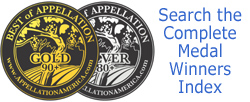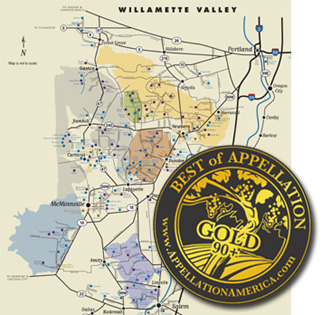
Willamette Valley’s Whites Peeking Out From Under
Pinot Noir Dominance
By taking a close look at the broader spectrum of Willamette Valley wines, it's quite evident that the region’s white wines also beg to be reckoned with. In particular, certain attributes of character and quality begin to come into focus for the footprint of Willamette Valley Pinot Gris, Pinot Blanc, and Riesling.
by Alan Goldfarb
August 4, 2008
 t’s a shame, but there are a lot of wonderful wines out there that are being lost in the shake-down of regional specialty. For instance, some very interesting New Zealand Pinot Noirs are being eclipsed by some of the best Sauvignon Blancs being made today in the same country. In Italy, it’s always been about Barolos and Barberescos and Brunellos and Super Tuscans, while those Italian Amarones, the Sagrantinos and the Aglianicos get their due only from some aficionados.
t’s a shame, but there are a lot of wonderful wines out there that are being lost in the shake-down of regional specialty. For instance, some very interesting New Zealand Pinot Noirs are being eclipsed by some of the best Sauvignon Blancs being made today in the same country. In Italy, it’s always been about Barolos and Barberescos and Brunellos and Super Tuscans, while those Italian Amarones, the Sagrantinos and the Aglianicos get their due only from some aficionados.
And so it is with the white wines of the Willamette Valley and its mosaic of sub-appellations that get short shrift because of Pinot Noir, which makes up a vast preponderance of the region’s production, and on which the region has rightfully made a claim to global fame.
But, by taking a close look at the broader spectrum of Willamette Valley wines – as our senior editors did in a recent round of BEST-OF-APPELLATION - it became quite evident that the region’s white wines also beg to be reckoned with. In particular, certain attributes of character and quality begin to come into focus for the footprint of Willamette Valley Pinot Gris, Pinot Blanc, and Riesling.
For instance, this sampling of Pinot Gris revealed that perhaps the Willamette appellation(s) aren’t where you go for crisp, dry wines. There’s a surprising heaviness, a fullness - they clearly want to make the big white wines in these parts.
Aromatically, there is some level of citrus zest and zinginess in the nose of these Pinot Gris. There’s also un-sweet fennel and definite phenolic bitterness (tannins and flavor compounds), and stone fruit, all of which are positive and quite enthralling.
“That’s how the distinct style of Alsace got going generations ago,” noted Clark Smith, oenologist and lead evaluator in the BOA Program. “The Alsatians wanted to make aromatic wines but they didn’t want to make French wines. For some winemakers in the Willamette case, making bigger whites with fullness and less acidity in a cool climate is clearly purposeful and staking out some pretty interesting grounds for distinctiveness.”
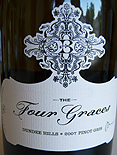 Take the 2007 Four Graces Pinot Gris ($18) from the Dundee Hills AVA, for example. This wine, from the center of the Willamette Valley, was advanced to highest standing in our BEST-OF-APPELLATION evaluation. It is green-gold to pale yellow in color, with peach, grapefruit and sandalwood aromas. In the mouth, the wine is right on the money. It certainly has a good measure of crispness, but, in the end, it fits the Willamette PG footprint of a wine that is full and voluptuous.
Take the 2007 Four Graces Pinot Gris ($18) from the Dundee Hills AVA, for example. This wine, from the center of the Willamette Valley, was advanced to highest standing in our BEST-OF-APPELLATION evaluation. It is green-gold to pale yellow in color, with peach, grapefruit and sandalwood aromas. In the mouth, the wine is right on the money. It certainly has a good measure of crispness, but, in the end, it fits the Willamette PG footprint of a wine that is full and voluptuous.
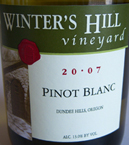 As for an exemplar of what a Willamette Pinot Blanc can offer – which is markedly distinct from Chardonnay, and even distanced from the local Pinot Gris – the 2007 Winter’s Hill ($18), also from the Dundee Hills, fits the bill.
As for an exemplar of what a Willamette Pinot Blanc can offer – which is markedly distinct from Chardonnay, and even distanced from the local Pinot Gris – the 2007 Winter’s Hill ($18), also from the Dundee Hills, fits the bill.
The character of this BEST-OF-APPELLATION award winning wine is defined by its almond, pear, and lime peel aromas. It is smooth and silky in the mouth, and has some minerality, which distinguishes it from Chardonnay. Pinot Blanc is challenging to make, but is emerging from under the shadow of Chardonnay in several appellations across North America, and the Willamette winemakers appear to be in the forefront of this very exciting development.
In global referencing the region’s effort with Riesling, we concluded from this particular BOA evaluation round that these wines have more in common with the Mosel than the Rhine. Also, while they don’t have as much fruit-forwardness or weight as many California renderings of this varietal, they do have an orange and nectarine quality more in the style of Australian Rieslings.
In the Mosel one has to seek out the warm spots in what is generally a cold region. Such is also the case in the upper Willamette region. Showing the way along this route to character and quality are the folks at Evergreen Vineyards, who have apparently located two such ideal sources for their Riesling. Their 2007 Spruce Goose Riesling ($16) sourced fruit from the Medici and Hyland vineyards. The latter, tucked into the
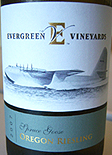 Chehalem Mountains just south of Portland, has vines that were planted in 1976. Hyland, in the McMinnville AVA to the south, was planted two years earlier. These are among the oldest vineyards in the broader Willamette Valley.
Chehalem Mountains just south of Portland, has vines that were planted in 1976. Hyland, in the McMinnville AVA to the south, was planted two years earlier. These are among the oldest vineyards in the broader Willamette Valley.
This BEST-OF-APPELLATION Riesling expresses itself with lime, Pippin apple and chalky aromas, plus touches of cinnamon and spearmint. That same cinnamon, and the addition of nectarine, translates to the mouth. Stylistically, the Spruce Goose has gorgeous sweetness in the front, then finishes with perfect balance of acidity and residual sugar.
Most of the Rieslings we tasted in this BOA round had a certain reduction quality, meaning that initially they were somewhat restrained and undeveloped, like a closed rose, which one can forgive as a promise rather than a defect. All of which portends well for Willamette Rieslings having a good upside for ageability.
And, in the promise & deliver department, every aromatic-geek out there (not to mention them what’s got romance in mind!) should keep an eye on Oregon Muscats, generally. To finish this round of Willamette Valley BOA evaluations, we had the pleasure of elevating the sparkling early Muscat from Tualatin Estate (made by Willamette Valley Vineyards) to BEST-OF-APPELLATION
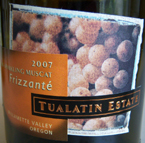 status. This is a seductress wine with slightly frizzante effervescence and stone fruit tannins that perfectly balance the 10 percent residual sugar, and modest alcohol…à la Muscat d’Asti.
status. This is a seductress wine with slightly frizzante effervescence and stone fruit tannins that perfectly balance the 10 percent residual sugar, and modest alcohol…à la Muscat d’Asti.
Overall, in this BOA evaluation round, the Valley’s eponymous producer, Willamette Valley Vineyards, once again demonstrated that a dedicated eye to terroir and a business plan geared to growth need not be contradictory. In addition to the Sparkling Muscat, WVV’s Pinot Gris, Riesling and Chardonnay were advanced to
 READER FEEDBACK: To post your comments on this story,
click here
READER FEEDBACK: To post your comments on this story,
click here
Print this article | Email this article | More about Willamette Valley | More from Alan Goldfarb










